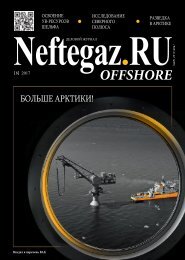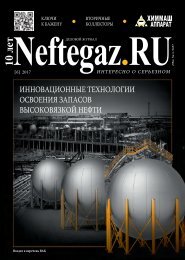Neftegaz.RU #3-17 ENG
Create successful ePaper yourself
Turn your PDF publications into a flip-book with our unique Google optimized e-Paper software.
EQUIPMENT<br />
FIG. 1. а) shear with compression, = 15°; b) shear, = 20°; c) shear and traction, = 25°<br />
Therefore cutting force shall be<br />
determined by the equation (2), and<br />
will increase along with Rs growth<br />
and shear angle decrease:<br />
FIG. 2. RDT screw cut trajectory inclination angles (for bits of various diameters)<br />
(2)<br />
where:<br />
mm 2 ;<br />
– area of bluntness,<br />
– thickness of the cut rock layer,<br />
mm;<br />
– radius of the cutting element<br />
installation, mm;<br />
– cut angle, degrees;<br />
– shear angle, degrees;<br />
– coefficient of cutting elements<br />
friction on rock.<br />
Operational capability of any<br />
cutting-type RDT shall be<br />
determined by reliability obtained in<br />
the process of rocks crushing with<br />
small radiuses at RDT axis where<br />
screw cut trajectory inclination<br />
angles (fig. 2) have the largest<br />
value and are determined by the<br />
ratio<br />
FIG. 3. Diagrams of wear of the drilling tools cutting blade reinforced by TC8 (on the left) and<br />
PCD (on the right) inserts<br />
where: – depth of RDT<br />
penetration per one rotation, mm/<br />
rot;<br />
– radius of the cutting element<br />
installation, mm.<br />
Cutting elements touchdown on<br />
rear edge leads to breakages<br />
caused by the effect of forces along<br />
the rear edge.<br />
Quite often the rear angle value is<br />
increased in order to reduce growth<br />
of the hard-alloy tools bluntness<br />
area. The Figure 3 shows diagrams<br />
of wear of the drilling tools cutting<br />
blade reinforced by TC8 (a) and<br />
PCD (b) inserts.<br />
Bluntness area growth peculiar<br />
for PCD inserts occurs only due to<br />
increase of the cutting edge length<br />
when the width along diamond layer<br />
remains constant, where F 1 = F 2<br />
= F 3 . Since PCD inserts diamond<br />
layer wear coefficient by 50 or more<br />
times exceeds tungsten-cobalt<br />
base material wear coefficient, it<br />
leads to higher PCD wear along<br />
the rear edge and to the rear angle<br />
formation. Thus PCD self-sharpens.<br />
Therefore, based on the<br />
calculations made by the equation<br />
2, it becomes evident that it is<br />
reasonable to apply smaller values<br />
of the rear angle for PCD with the<br />
front angle and the rear angle<br />
being interrelated constructively.<br />
This will lead to decrease of the<br />
cutting angle and decrease of<br />
the negative front angle , and<br />
consequently to reduction of the<br />
cutting force F cut .<br />
[3] <strong>Neftegaz</strong>.<strong>RU</strong> ~ 49














